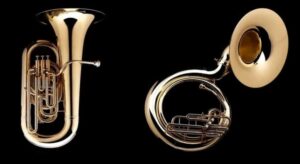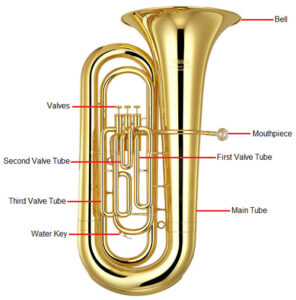Contents
- 1 The Origins and Fascinating History of the Tuba
- 1.1 The Early History of the Tuba
- 1.2 Development and Evolution of the Tuba
- 1.3 Famous Tuba Players and their Contributions
- 1.4 The Tuba in Orchestras and Bands
- 1.5 Different Types of Tubas
- 1.6 The Anatomy and Components of the Tuba
- 1.7 The tuba’s role in Various Music Genres
- 1.8 Conclusion: The enduring legacy of the tuba
The Origins and Fascinating History of the Tuba

Step into the world of music as we explore the origins and captivating history of the tuba. This majestic instrument, with its deep, resonant sound, has a story that spans centuries and continents. From its humble beginnings in the early 19th century to its prominent role in modern symphony orchestras, the tuba has left its mark on the music world.
Initially developed in Germany, the tuba was created as a means to produce lower, richer tones in ensembles. Its design has evolved over time, with advancements in materials and techniques allowing for a wider range of sound and greater versatility. Today, the tuba is a key component in brass bands, concert bands, and orchestras worldwide.
Join us as we delve into the fascinating history of this instrument, uncovering its role in different musical genres and the notable composers and performers who have embraced it. Discover how the tuba has influenced the way we appreciate and enjoy music, and gain a deeper appreciation for this brass wonder.
Whether you’re a music enthusiast, a history buff, or simply curious about the stories behind musical instruments, this article will provide you with an engaging journey through the origins and captivating history of the tuba.
The Early History of the Tuba
The tuba is a brass instrument that produces the lowest notes in an orchestra. It was invented in the early 19th century by combining elements of other instruments, such as the ophicleide and the serpent. The first tubas had valves that allowed them to play different pitches, unlike their predecessors. The tuba soon became popular in military bands and symphonies, and composers began to write music for it. Some of the famous tuba players in history include William Bell, Arnold Jacobs, and John Fletcher.
Development and Evolution of the Tuba
The Tuba evolved from earlier instruments such as the serpent and the ophicleide, which had wooden bodies and metal keys. The first tuba was invented in 1835 by Wilhelm Friedrich Wieprecht and Johann Gottfried Moritz in Germany. They designed it to have a conical bore, a wide bell, and valves that could change the pitch. The tuba was soon adopted by composers such as Richard Wagner, who used it to create powerful and dramatic effects in his operas. The tuba has continued to develop over time, with different sizes, shapes, and tunings. Today, the tuba is used in various musical genres, from classical to jazz to pop.
Famous Tuba Players and their Contributions
Tuba players are often overlooked in the history of music, but they have made significant contributions to various genres and styles. Some of the most famous tuba players are:
- William Bell: He was the principal tubist of the New York Philharmonic for 30 years and a renowned soloist and teacher. He composed many pieces for tuba and helped popularize the instrument in classical music.
- John Fletcher: He was the first tubist to perform a concerto with the London Symphony Orchestra and a founding member of the Philip Jones Brass Ensemble. He was known for his virtuosic technique and expressive tone.
- Howard Johnson: He is a versatile musician who has played tuba, baritone saxophone, and other instruments in jazz, funk, rock, and blues. He has collaborated with artists such as Miles Davis, Taj Mahal, and John Lennon, and led his own tuba ensemble called Gravity.
- Carol Jantsch: She is the first female tubist to hold a principal position in a major orchestra, namely the Philadelphia Orchestra. She is also an active soloist, chamber musician, and educator. She has performed with artists such as Yo-Yo Ma, Wynton Marsalis, and Sting.
The Tuba in Orchestras and Bands
The tuba is the largest and lowest-pitched brass instrument in orchestras and bands. It plays an important role in providing the bass foundation for the harmony and rhythm of the music. The tuba can also produce expressive melodies and solos, especially in jazz and pop genres. The tuba has a rich and warm sound that can fill a large concert hall or a small club.
Different Types of Tubas
There are different types of tubas, such as the contrabass tuba, the bass tuba, the tenor tuba, and the euphonium. The contrabass tuba is the largest and lowest-sounding tuba, while the euphonium is the smallest and highest-sounding tuba. The bass tuba and the tenor tuba are intermediate in size and pitch. Tubas are used in various musical genres, such as classical, jazz, marching band, and pop music.
The Anatomy and Components of the Tuba

The tuba is the largest and lowest-pitched brass instrument. It consists of a mouthpiece, a valve section, and a bell.
- The mouthpiece is where the player blows air into the instrument.
- The valve section has three or four valves that change the length of the tubing and the pitch of the sound.
- The bell is the flared end of the instrument that amplifies the sound and directs it outward.
The tuba’s role in Various Music Genres
The tuba is a brass instrument that produces low-pitched sounds. It is often used in various music genres, such as classical, jazz, pop, and marching band music. The tuba’s role in these genres varies depending on the style, mood, and arrangement of the music.
- In classical music, the tuba usually plays the bass line or supports the harmony of the orchestra. It can also play solo or in small groups, such as tuba quartets or quintets. Some famous classical composers who wrote for the tuba include Richard Wagner, Gustav Holst, and Ralph Vaughan Williams.
- In jazz music, the tuba can replace the double bass or the electric bass in some styles, such as Dixieland or New Orleans jazz. It can also play rhythmic patterns or improvise melodies along with other instruments. Some notable jazz tubists include Howard Johnson, Bob Stewart, and Kirk Joseph.
- In pop music, the tuba can add a rich and deep sound to the songs. It can also create contrast or surprise effects when paired with other instruments or vocals. Some examples of pop songs that feature the tuba are “Bohemian Rhapsody” by Queen, “You Can Call Me Al” by Paul Simon, and “All You Need Is Love” by The Beatles.
- In marching band music, the tuba is essential for providing the foundation and power of the sound. It can also play melodies or fanfares that enhance the spirit and excitement of the music. Some examples of marching band pieces that showcase the tuba are “Stars and Stripes Forever” by John Philip Sousa, “The Horse” by Bill Chase, and “Malaguena” by Ernesto Lecuona.
Conclusion: The enduring legacy of the tuba
The tuba is more than just a musical instrument. It is a symbol of cultural identity, social resistance, and artistic expression. The tuba has been used by various groups throughout history to assert their voice, challenge oppression, and celebrate diversity. The tuba is not only a source of sound, but also a source of inspiration. The tuba’s enduring legacy is its ability to connect people across time, space, and difference.
